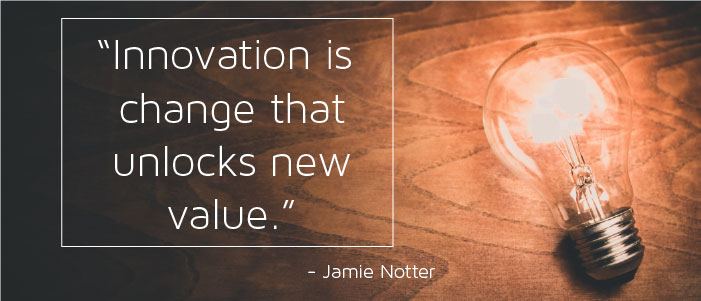In his introduction to the 2017 NSW Disability Innovation Awards, NSW Minister for Disability, the Hon. John Ajaka MLC, said “…the National Disability Insurance Scheme (NDIS) is triggering an unprecedented wave of growth and innovation. The Scheme requires staff and providers to consider new and better ways of thinking and doing”. This is an example of Government’s current penchant for linking policy reform to innovation as a driver for growth, competitive advantage and procurement.
I agree innovation has merit for Disability Services Organisations, particularly under the current regulatory and budgetary landscape. However, as we see it increasingly touted across a range of Federal and State Government Departments, there is danger “innovation” will become an overused, misunderstood term with its value unrealised. A clear and common understanding of innovation is a critical, but often overlooked, step in addressing an organisations capacity and capability to innovate. With this in mind, below are 5 key innovation concepts that I believe providers in the Disability Services sector need to better appreciate and disseminate throughout their organisations.
1. Innovation is acutely connected to value: Innovation is not necessarily about ‘things’. More broadly, innovation is about changed practices within a community of practice. It takes place when a group of people begin doing something differently because they perceive there is a value in doing so. This means the success of an innovation is determined more by the extent of its adoption than by who originates it or how technologically advanced it is.
2. Innovation is acutely connected to change: Good ideas are common but there are many reasons they never progress. They may be scientifically impossible, impractical, too expensive or simply not valued. Inventions are good ideas that have been turned into a new product, service or offering. However, inventions may also never reach the market. Innovations, on the other hand, are products, services or offerings that have been adopted by a community of individuals. Innovations are an outcome of a mindset or culture where change is seen as an opportunity and is embraced. They depend on a willingness to do things that have not been done before. This mindset towards change is therefore a driving force behind innovation.
3. Innovation can be achieved in multiple ways: The importance of innovation lies in its relationship to competitive advantage. Innovation can lead to new products and services that create competitive discriminators. Equally, competitive advantage can be derived from innovations in the process by which goods and services are delivered. Organisations need to consider a wider view of innovation and look beyond just ‘new products or services’. Successful innovation can also be achieved through new organisational structures, new business models and new administrative systems, process technologies, plans and programs.
4. Innovation is dependent on the commercialisation of creativity: While innovation is not just about creativity, it is usually dependent on creativity – a mental and a social process involving the generation of new ideas or concepts, or new mental associations between existing ideas and concepts. So, part of the innovative process is encouraging creativity and the generation of new ideas. However, not all creative ideas will succeed (that is, be adopted by customers or communities of practice). Therefore, organisations need to focus on implementing an innovation framework that supports creativity and selecting and transforming the best resulting ideas in to commercially viable innovations.
5. Innovation is a cyclical process: Innovation often begins when something radically new is developed and offered to the world. Initially, there are many alternative designs and various different implementation avenues. Eventually, one concept wins the market war to become the dominate offering to which all producers adhere. The innovation becomes mainstream and the cycle begins again as the world waits to be offered value in something new. This is why developing an innovative organisation is critical to long term survival. It provides the environment, capacity and capability to continuously develop the new products, services and practices that will enable long term competitive strength.
With innovation driving competitive advantage and acting as a key influencer of Government and private procurement decisions, it will be important for Disability and Social Support Service providers to develop innovative organisations. To do this, a mutual understanding of how innovation functions and how it benefits internal and external stakeholders is crucial. It’s nigh on impossible to have an innovative organisation without a culture that supports it. Therefore, innovation must not be allowed to become just another buzzword that invokes cynicism rather than optimism.

